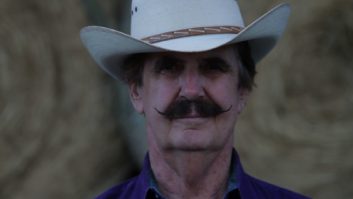Of the recent spate of documentaries about life in the studio, Muscle Shoals(Magnolia Pictures, 111 Minutes) stands out for what it is not. It is not about analog versus digital, or fetishizing gear, or producer theory or any of that stuff. It’s about things far more ephemeral and less defined, like ambition, joy, pain and all the other messy, human stuff that came along when a sleepy Alabama town, population 8,000, became a musical prism that focused R&B music into a colorful, blinding light.

Dozens of artists weigh in throughout, sharing their insights and experiences recording in the town, like Aretha Franklin, Bono, Alicia Keys, Steve Winwood, Gregg Allman, Clarence Carter, Keith Richards, Mick Jagger, Jimmy Cliff, Percy Sledge, Wilson Pickett, and others.
Despite the big names, if there’s a central focus, it’s Rick Hall, the soulful, gruff founder of FAME Recording Studio. As Muscle Shoals unfolds and he turns a former candy and tobacco warehouse into a veritable hit factory, however, it becomes clear that the story is an ensemble piece, with a wide-ranging cast of music legends and session musicians that together created a body of work greater than the sum of its parts.
While Hall’s personal life was plagued by horrendous, tragic accidents, he became increasingly driven to achieve greater success for his studio, a place where he had control away from the capricious world outside. Over the course of the 1960s and ’70s, he put together three teams of world-class session musicians, among them the FAME Gang and the Swampers, all of whom played on some of the biggest tracks of the day—classic singles from the likes of Franklin, Sledge and Arthur Alexander.
Ironically, given the racial tensions in Alabama during the Civil Rights movement, FAME was a comparative oasis where white and black musicians worked together without issues as they laid down innumerable funky sides. “A lot of people couldn’t believe that my whole band was white guys that played behind me,” says Sledge with a laugh.
There was still plenty of drama to go around, however. A new session trumpet player’s too-friendly repartee with Aretha Franklin blew up into a drunken brawl between Hall and Franklin’s then-husband on a fourth-floor balcony. That, in turn, caused legendary Atlantic Records producer Jerry Wexler to end the run of hits he’d recorded at the facility. Both men recount the story and Hall coldly concludes, “Wexler came to me and said ‘I will never set foot in this studio again as long as I live. I will bury you!’ I said, ‘You can’t bury me,’ and he said ‘Why can’t I?’ ‘Because you’re too old—I’ll be around after you’re gone.’”
While Hall recovered, recording for Chess and later on, Capitol Records, Wexler’s hand was felt again when the Swampers—named-checked in Lynyrd Skynyrd’s “Sweet Home Alabama”—broke away to found their own facility, Muscle Shoals Sound Studios. Initially bankrolled by Wexler, the new studio across the tiny town attracted even more artists to the area, like Bob Seger and Traffic. At its mid-Seventies highpoint, the facility was tackling 50 albums a year, with artists flying in from all over the world.
Take the Rolling Stones: They were in Muscle Shoals for only two days in the early 1970s, but as Jagger and Richards recall—and as shown through a surprising amount of film shot during their brief stay—it was a prosperous visit, with the band knocking out multiple tracks, including future classics “Wild Horses” and “Brown Sugar.”
“I thought it was one of the easiest and rockinest sessions that we’d ever done,” says Richards with a cackle. “I don’t think we’ve been quite so prolific ever. I mean, we cut three or four tracks in two days and that for the Stones is going somewhere. We left on a high with ‘Brown Sugar;’ we knew we had one of the best things we’d ever done. I always wanted to go back there and cut more, you know, then shit happened, so we ended up in France in a basement, doing Exile On Main Street there, but otherwise Exile would’ve probably been cut in Muscle Shoals. Politically it wasn’t possible, because I wasn’t allowed in the country at the time!”
Throughout, stars expound on the vibe of the area, and the beautifully shot scenery often takes viewers out of the studios, allowing the countryside and the town itself to become a character, too. The film glosses over what happened in more recent times—Muscle Shoals Sound Studios eventually closed, its building only recently purchased by the local historical society in an effort ironically spearheaded by Hall’s son—but things end on a positive note as the Swampers return to FAME to play behind Alica Keys, with Hall once again manning the console.
While Muscle Shoals is a sprawling and enjoyable film on its own, the DVD and Blu-ray come with numerous extras, including a commentary by director Greg Camalier, and another with Hall and the Swampers, plus a truckload of cut scenes and interviews that bring additional insight into the incredible tale of a small town in the middle of nowhere that created some of the best music of an era.
Muscle Shoals at Amazon
http://amzn.to/1ouqmFA





